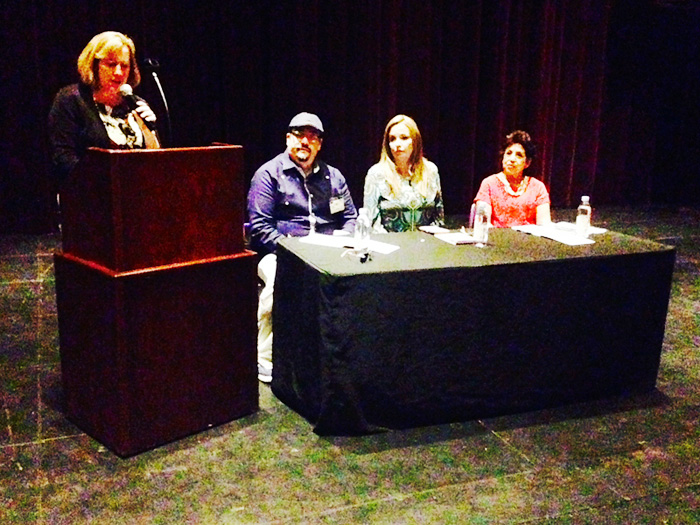Events
Latinos in Lafayette
In 2015 LEH partnered with libraries, UL Lafayette for series of discussions and film screenings
Published: October 28, 2015
Last Updated: August 29, 2018
The Latino Americans initiative in Lafayette, part of a nationwide program funded by the National Endowment for the Humanities (NEH) and the American Library Association (ALA), offered six different programs that presented the parish’s residents with diverse options for engaging with this important but largely undocumented local history, ranging from screenings of an acclaimed PBS documentary series, related panel discussions, Spanish translation of an app for touring landmarks in downtown Lafayette, and an oral history project on November 7, 2015. Kathleen Espinoza, a professor at the University of Louisiana Lafayette, and her students invited local Latino American residents to this recording session—in either Spanish or English—to collect stories about their roots, their family lives and their role in Lafayette’s culture and economy. Sessions took place in the second floor meeting room of the main branch of the Lafayette Public Library (301 W. Congress Street, lafayettepubliclibrary.org).
According to U.S. Census statistics, of the 225,000 people who live in metro Lafayette, an estimated four percent, averaging about 9,000 residents, are Latino, and related data shows that all 21 nations of Latin America are represented. Long before the border between Mexico and the U.S. was drawn along the Rio Grande in 1848, the Attakapas prairie where Lafayette would eventually be sited was part of the Baja Luisiana territory ruled by governors of the Spanish Viceroyalty in Nueva Orleans from 1762–1802. The area was sparsely populated, but Canary Island settlers known as Isleños who were displaced by back-to-back hurricanes in 1779 and 1780 at Barataria (St. Bernard Parish) found higher ground at Valenzuela, near present-day Plattenville in Assumption Parish. There they intermarried with Cajuns. Another well-documented Spanish-speaking community existed at Galveztown (Ascension Parish), an outpost established in 1778 that has been the site of recent archaeological excavations. Even the spicy meat and rice dish of jambalaya, a Cajun mainstay which bears a strong resemblance to paella, is believed to have culinary roots in the era of 18th-century Spanish rule. Espinoza’s oral history work, however, will largely focus on more recent arrivals.
“By hearing the stories of the Latino community in Lafayette, my students will better understand the challenges and aspirations of a minority population,” said Espinoza. “By recording and archiving the stories of Latino immigrants we hope to preserve an important period of change in Lafayette so that the larger community will have a record of a unique population and its contribution to the larger cultural mix of the city.”
Three of Lafayette’s Latino community activists shared their thoughts on Oct. 3 at a panel discussion led by Espinoza prior to the screening of Peril and Promise, one in a series of six PBS documentaries spanning 500 years of history of Spanish-speaking peoples in North America. This episode spans the years 1980–2000, a period when the Latino population in the U.S. more than doubled, from 14.6 million to 35 million.

Professor Kathleen Espinoza led a panel discussion with three Latino community activists in Lafayette: Juan Paredes, president of the Asociación Latino Cultural Acadiana; Patricia Morales, pastor of the Alpha and Omega International Church in Lafayette; and Georgina Ocampo, translator with the English as a Second Language Program in the Lafayette Parish Public Schools. photo by David Johnson
Georgina Ocampo, a translator with the English as a Second Language Program in Lafayette Parish Public School System spoke about the language barrier that confronts Spanish-only speakers. “Many immigrants have to ask relatives, friends or neighbors to take them to the grocery store, the doctor or even to the school when they have a kid who is sick,” she said. “That’s a big challenge for the families.”
Patricia Morales, pastor of the Alpha and Omega International Church in Lafayette added, “Many adults have no idea where to learn English, but many learn it through their children. It can take years to adapt.”
Juan Paredes, president of the Asociación Cultural Latino Acadiana (ACLA), pointed out that bilingual aid is available. “ACLA began working in 2010 to establish a referral network between physicians who speak Spanish or have a Spanish-speaking staff.” His group is working on the digital tour app that will be offered in English, French and Spanish.
Morales describes assimilation for Latino immigrants as a “process of valuing who you are and valuing the place you have come to without losing your identity. We have developed something new here — a Latino-Acadiana culture.” She encourages non-Hispanic residents of the region to “bring down that barrier — don’t be afraid to reach out and communicate. [Latinos] are here for a better future, just like you and I are.”
Through the Latino Americans program, the LEH and its partners helped to generate a sustained public dialogue through public humanities programs that examine the influence of Latino Americans within the region; renew exploration of the period of Spanish-colonial Louisiana, and document the contemporary Latino American experience in Acadiana. In each case, the LEH will create new bilingual opportunities to engage all Lafayette residents. Screenings of other documentaries were hosted at the Hilliard Museum, and portions of the oral histories were transcribed and printed in the Spring 2016 edition of Louisiana Cultural Vistas.
Partners in this project include the Lafayette Parish Library, the Asociación Cultural Latino Acadiana, the Dupre Library at the University of Louisiana at Lafayette, the Mexican Consulate in New Orleans, the Hilliard Museum and the Lafayette International Trade Center, a branch of the City of Lafayette. Local NPR affiliate KRVS 88.7 FM, will assist in media outreach.
